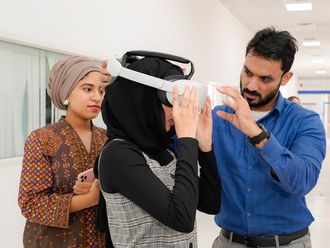
Under the patronage of Dubai Health Authority (DHA) and in partnership with Arab Health, a unique international collaboration saw fruition this Ramadan as Belinda Gatland, a British expat in Dubai, received the region’s first ever fully 3D-printed prosthetic leg.
“DHA has prioritised fostering the development of future technologies such as 3D printing in healthcare,” said His Excellency Humaid Al Qatami, Chairman of the Board and Director General of DHA.
The region’s first custom prosthetic leg was revealed at Arab Health 2017 in January. DHA and Arab Health facilitated the creation and donation of the prosthetic device in conjunction with Prosfit (Bulgaria), Mecuris (Germany), and Mediclinic (UAE).
“Such projects help us pave the way towards a more integrated and sustainable healthcare system,” said Dr Mohammad Al Redha, Director of the Executive Office for Organisational Transformation at DHA.
With more than 20 years of experience in the field, Sebastian Giede, Certified Orthopaedic Prosthetist at Mediclinic, worked with the fully 3D-printed device for the first time. “The potential of 3D printing in the field of prosthetic devices is huge,” says Giede.
Belinda Gatland, an equine sports therapist, has been an amputee for more than ten years. After breaking her leg in a horse riding accident at the age of 22 and subsequent necrosis (premature death of tissue or bone cells) leaving her in immense pain, Gatland ultimately took the decision to have her leg amputated at 40.
“After trying to save my leg for 19 years and managing the pain, doctors informed me that I had no choice,” says Gatland. “They said that my leg had to come off because the bones had died. If I left it much longer, the necrosis would spread higher and lead to an over-the-knee amputation.”
Difficult decision
It was the hardest decision of Gatland’s life, but the prospect of being able to be more hands-on with her son, who was then four years old, gave her the courage to go ahead with her decision.
Within seven weeks of her amputation, Gatland resumed work. “You just have to carry on in life; and horses have been my passion. So after my fall, I studied to become an equine sports therapist because I could no longer ride.”
In 2012, she went to the London Olympic Games as team physiotherapist for the horses of Team Japan, who train in the UK.
Gatland is the first amputee in the region to wear a completely 3D-printed prosthetic leg. “I have always campaigned for prosthetics being more accessible ever since I became an amputee,” she says.
“Prosthetics are very expensive and need to be changed regularly, especially for children who require them and are of a growing age.”












